 On May 19th 2013, fans of The X-Files were given a rare treat; a chance to spend time with the minds behind the art of The X-Files. The event, held at the iconic Egyptian Theater in Los Angeles, and celebrated by the Art Directors Guild Film Society, the American Cinematheque, and The Hollywood Reporter, brought together production designer Corey Kaplan (The X-Files, Scandal, Cold Case, Robbery Homicide Division), writer-producer-director Vince Gilligan (The X-Files, Breaking Bad, The Lone Gunmen, Harsh Realm) and Creator-Writer-Producer-Director Chris Carter (The X-Files, Harsh Realm, Millennium, The Lone Gunmen). Moderated by production designer John Muto (Home Alone, River’s Edge, Terminator 2 3-D), the event presented the art and design of The X-Files by screening “Je Souhaite” and “Triangle” and included a panel discussion.
On May 19th 2013, fans of The X-Files were given a rare treat; a chance to spend time with the minds behind the art of The X-Files. The event, held at the iconic Egyptian Theater in Los Angeles, and celebrated by the Art Directors Guild Film Society, the American Cinematheque, and The Hollywood Reporter, brought together production designer Corey Kaplan (The X-Files, Scandal, Cold Case, Robbery Homicide Division), writer-producer-director Vince Gilligan (The X-Files, Breaking Bad, The Lone Gunmen, Harsh Realm) and Creator-Writer-Producer-Director Chris Carter (The X-Files, Harsh Realm, Millennium, The Lone Gunmen). Moderated by production designer John Muto (Home Alone, River’s Edge, Terminator 2 3-D), the event presented the art and design of The X-Files by screening “Je Souhaite” and “Triangle” and included a panel discussion.
What made this event unique is that as a television viewing audience, we often celebrate and obsess over actors, and at times writers and producers. We become deeply connected to the characters and to the story of the hardships they face. However, the world that is created by the Art Department under the guidance of the Production Designer often goes unmentioned. This is likely due to the ability of the visual medium to submerse the viewer into an environment so compelling that we momentarily suspend belief. We forget the complexities of set design and construction, of picking out the right costumes and maintaining outfit continuity, of choosing makeup that both enhances the character yet seems realistic, of creating convincing special effects, and the arduous search for the perfect location. The style that unifies the image goes unnoticed because Production Design, when done right, complements the story and actors so well it becomes their world.
It is the job of the Production Designer to tell a visual story by taking the words off the page of the script and manifesting them on screen. Working alongside the cinematography department, they create a world that both matches and enhances the characters and their story. By utilizing sets, locations, props, special effects, costume design, framing, lighting, and pacing, the image communicates not only visual information but also emotional information.
Production Design on The X-Files took this a step farther. The visuals of The X-Files not only brought us into the world of Mulder and Scully, they also gave validity to a science fiction genre that is often plagued with big ideas but campy production by telling complex stories with fantastical elements in a believable way. With The X-Files, sci-fi suddenly found a mainstream audience.
The Pilot
 The pilot does an excellent job of setting up the viewer for the nature of the show by utilizing emotional information through production design. After a fade in, we see a female running in a sky blue nightgown, her figure barely lit by the moon as she becomes encapsulated by the shadows of the woods. We only see her face as a dark figure approaches and a bright light fills the screen then fades to the dead body of the young woman. In this scene we understand her fear through the visual medium and we are left to question what happened.
The pilot does an excellent job of setting up the viewer for the nature of the show by utilizing emotional information through production design. After a fade in, we see a female running in a sky blue nightgown, her figure barely lit by the moon as she becomes encapsulated by the shadows of the woods. We only see her face as a dark figure approaches and a bright light fills the screen then fades to the dead body of the young woman. In this scene we understand her fear through the visual medium and we are left to question what happened.
A low lighting source enhances the production design by appearing throughout the pilot with several different types of light: moonlight, streetlights, headlights, flashlights, slideshow projector lights, police lights, fire light, and candlelight. At its most intense moments, the lighting is reduced and the use of window shades, rain, and foliage are used to create eerie or strong emotional moments, such as when Mulder reveals his sister’s abduction to Scully in the motel room. The episode features prominent sets such as Mulder’s office, which automatically gives the viewer visual cues as to Mulder’s character. The IWTB poster, photos, and office clutter suggest a man both obsessed with the paranormal and his work. 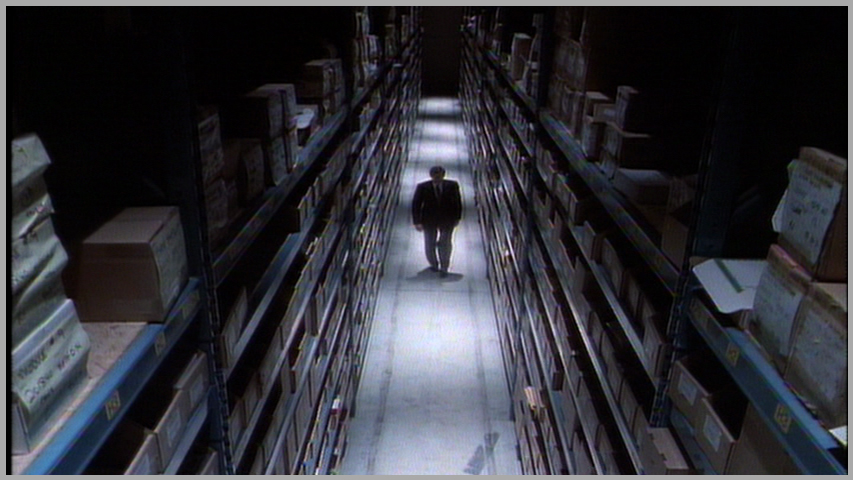 Along with the dim lighting situations, the costume design maintained a subdued neutral color palette and established the two tone suits for Mulder and Scully. For visual effects, the chimpanzee alien body in the casket, the nosebleed from Theresa Hoese, and the leaves circling Billy towards the end of the episode all stand out as well done and help drive the episode forward. At the end of the episode, as Cancerman logs the evidence, the viewer is informed of the vastness of the room by the large shelving units, and even though you only see one row, you are led to believe the room is much larger. The use of signage outside the door clues the viewer in that the evidence is being stored in a secure facility at the heart of the Pentagon, and the viewer suddenly realizes how deep the conspiracy goes.
Along with the dim lighting situations, the costume design maintained a subdued neutral color palette and established the two tone suits for Mulder and Scully. For visual effects, the chimpanzee alien body in the casket, the nosebleed from Theresa Hoese, and the leaves circling Billy towards the end of the episode all stand out as well done and help drive the episode forward. At the end of the episode, as Cancerman logs the evidence, the viewer is informed of the vastness of the room by the large shelving units, and even though you only see one row, you are led to believe the room is much larger. The use of signage outside the door clues the viewer in that the evidence is being stored in a secure facility at the heart of the Pentagon, and the viewer suddenly realizes how deep the conspiracy goes.
Favorite scenes from The Pilot
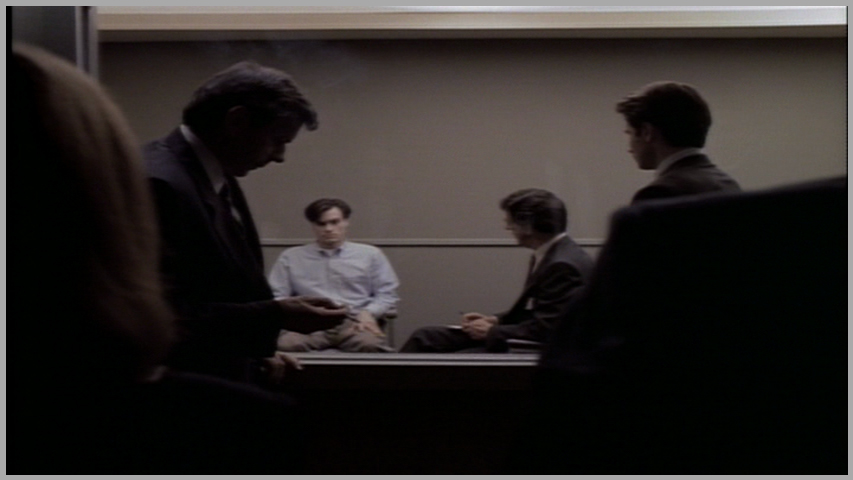 When Scully enters the FBI in the beginning to go to Blevins office and passes all the office workers, and even as she talks to Blevins, you see people through the blinds moving around. This gives the viewer visual cues that there is a much larger world than what is being filmed.
When Scully enters the FBI in the beginning to go to Blevins office and passes all the office workers, and even as she talks to Blevins, you see people through the blinds moving around. This gives the viewer visual cues that there is a much larger world than what is being filmed.
The silhouette of Cancerman, with his head bowed, as Billy recounts the abductions in the brightly lit interrogation room. This scene is interesting in that the viewer questions why Cancerman is there, and begins to wonder about his connection to what happened to Billy.
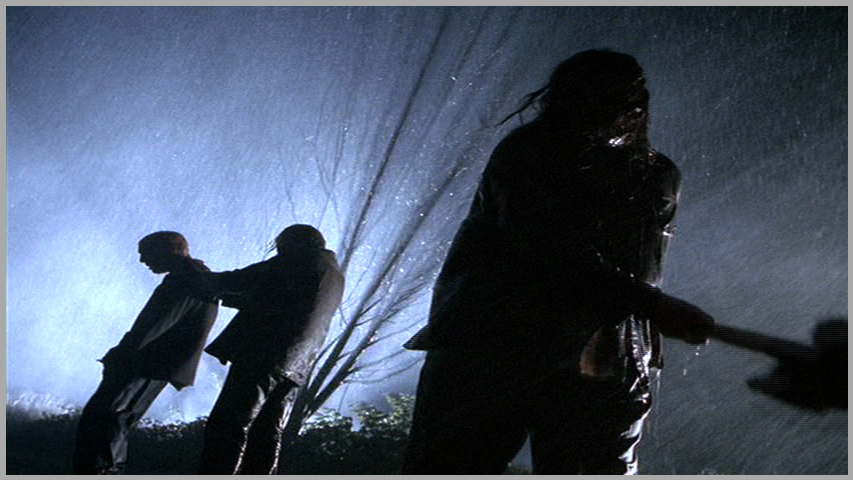 'Home'
'Home'
It would be easy to congratulate the special effects department on the makeup and prosthetics of the Peacock family and be done with this; however, this episode features some extraordinarily well designed production design with a remarkably small amount of locations for an episode including: the Peacock’s House, the Sheriff’s station, the Hotel, and the Sheriff’s House. As with the pilot, lighting during the opening scenes plays an important role in setting the mood. The lighting filters through the vines with the sickle and then continues with the addition of candlelight to set the ambiance for the grisly birthing scene. This low level lighting enhances the suspense while the candlelight enhances the abnormalities of the Peacock’s faces. Following the birth, the shot of the baby’s last view as the man shovels dirt onto his body is riveting. The baby’s hand also plays a symbolic role of the need for help as it reaches from the dirt where the boys playing baseball discover it. It is only later that we see the baby’s body, most likely so that the viewer does not write off what happened to the child as a result of his deformities.
“Home” makes great use of light and dark with many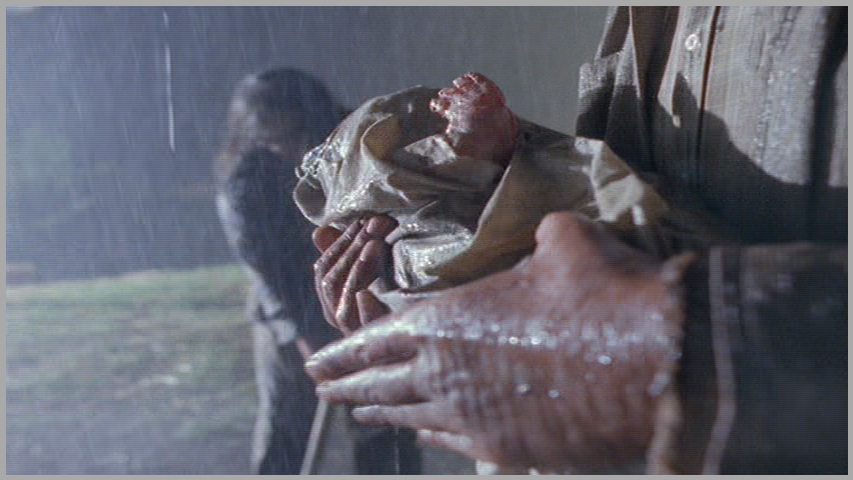 of the exterior shots of the town showing a sunny, perfect day in contrast to the interior of the Peacock’s House which is starkly dark in comparison. While the darkness is technically due to a lack of electricity, it serves as a symbolic way to hide the dark secrets of the Peacock family, which Mulder and Scully later begin to uncover, as they enter the house upon seeing a pair of bloody scissors. Lighting is effectively used as the camera zooms in on the eyes of a hidden figure as Mulder and Scully search the house.
of the exterior shots of the town showing a sunny, perfect day in contrast to the interior of the Peacock’s House which is starkly dark in comparison. While the darkness is technically due to a lack of electricity, it serves as a symbolic way to hide the dark secrets of the Peacock family, which Mulder and Scully later begin to uncover, as they enter the house upon seeing a pair of bloody scissors. Lighting is effectively used as the camera zooms in on the eyes of a hidden figure as Mulder and Scully search the house.
Probably the most interesting aspect of “Home” is that it really deals with the struggle of two sides trying to maintain their way of life. As the Sheriff takes a nondescript gray box out of his desk, he opens it and pulls out a pistol. We see his character struggle with the thought of using it. He puts it back. Later, as the Peacock brothers get in their car to head to the Sheriff’s home, the choice of car is of great interest as it lends to the notion of a bygone era, which this episode heavily deals with. The Peacocks and the Sherriff are both in a struggle to hold on to their way of life against outside forces. As the Sheriff is being bludgeoned, the camera angle from his wife’s POV, along with her attempt to muffle her anguish as his blood creeps along the floor towards her fingers, heightens the viewer’s sense of impending doom. The viewer fears for her, knowing she can’t escape. Some may have thought this scene too brutal, and in fact the episode was banned for years from being re-shown on the network, but this brutal scene highlights the desire for peace with the reality of violence.
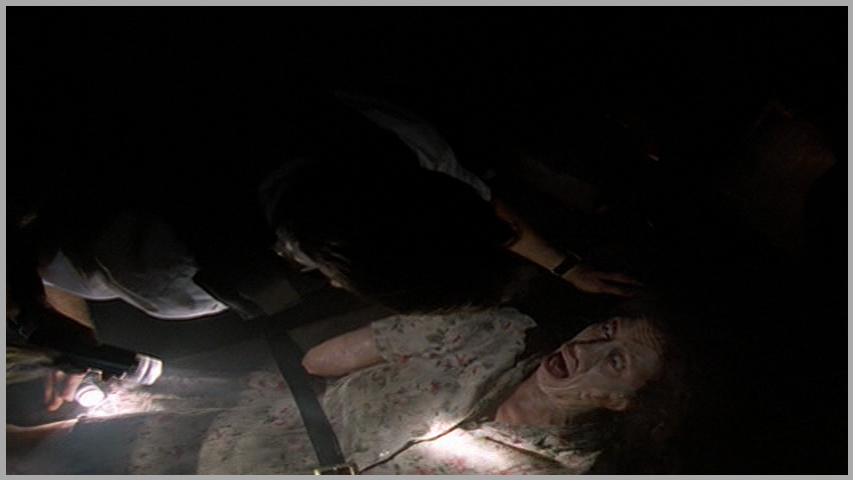 The success of the production design in “Home” lies in locations that feel like real places rather than poke a rural living. As Mulder uses a 2x4 to open a door and the trap springs, the door cracks from the pressure and the panes break. It makes the viewer feel as if the characters are in true danger. The special effects to make the Peacock mother a quadriplegic was also both outstanding and wholly believable. The old family photos are informative and help to identify the woman to the viewer. Another item of note is that the costume design in this episode absolutely fits the characters. For the Sheriff who took great pride in his job, his uniform was clean and pressed. While the clothes of the Peacocks were dirty and disheveled, their costumes fit with the rural styles of the Amish and Mennonites, two equally reclusive groups that take pride in family.
The success of the production design in “Home” lies in locations that feel like real places rather than poke a rural living. As Mulder uses a 2x4 to open a door and the trap springs, the door cracks from the pressure and the panes break. It makes the viewer feel as if the characters are in true danger. The special effects to make the Peacock mother a quadriplegic was also both outstanding and wholly believable. The old family photos are informative and help to identify the woman to the viewer. Another item of note is that the costume design in this episode absolutely fits the characters. For the Sheriff who took great pride in his job, his uniform was clean and pressed. While the clothes of the Peacocks were dirty and disheveled, their costumes fit with the rural styles of the Amish and Mennonites, two equally reclusive groups that take pride in family.
Favorite Scene from 'Home'
The burial of the baby was excellently executed. The visuals were both beautiful and disturbing at the same time. The Peacock brother crying while another comforts him; the dark figure with a shovel in the rain as lightning illuminates his frame; the baby’s wails as its hand protrudes its cover. It culminated in a deeply moving scene.
'Theef'
 The introduction to this episode does a good job of setting up Doctor Robert Wieder as a wealthy, successful family man. He appears by all accounts a nice person. We glean this from the large house, the physician of the year award, his interaction with his family, and the inclusion of several framed photos of the family smiling. However, all is not well as Wieder’s father-in-law throws back the covers to get into bed and there’s dirt in the shape a small man on the sheets. A slightly disfigured man, Orel Peattie, appears behind him and the house alarm goes off.
The introduction to this episode does a good job of setting up Doctor Robert Wieder as a wealthy, successful family man. He appears by all accounts a nice person. We glean this from the large house, the physician of the year award, his interaction with his family, and the inclusion of several framed photos of the family smiling. However, all is not well as Wieder’s father-in-law throws back the covers to get into bed and there’s dirt in the shape a small man on the sheets. A slightly disfigured man, Orel Peattie, appears behind him and the house alarm goes off.
In this episode the lighting is brighter than in the previously mentioned episodes. Here the episode uses the sound of the motion detector and the length of time it takes for Wieder to investigate to heighten the tension. Weider slips in the blood as he finds his father in law hung. “Theef” is scrawled on the wall using the victim’s blood, the body of the victim framed perfectly. The house of the doctor’s, which is well lit, clean, and well decorated with floral arrangements and framed artwork, stands in stark contrast to the dark, yellow lit, rundown apartment where Peattie is staying. It’s wonderfully done, which is also the reason I picked this episode. We see an obese woman hand rolling the cheap carpet in a room filled with cheap furniture and lit by cheap lighting fixtures that are poorly maintained. T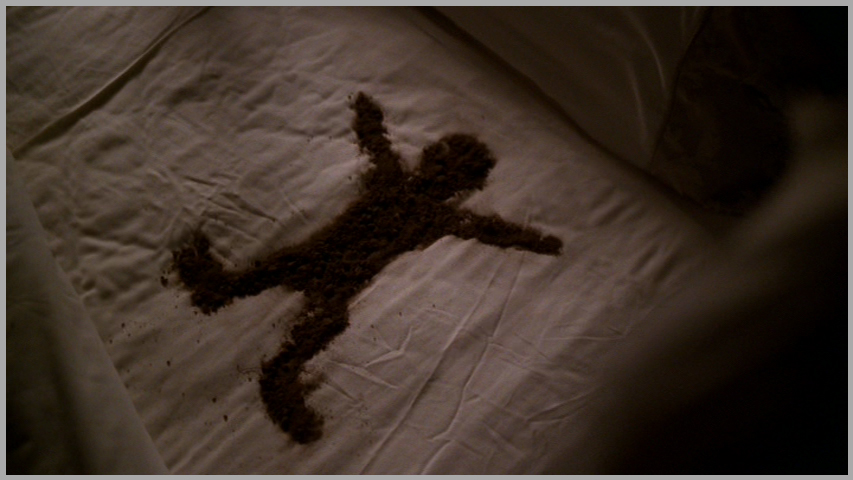 he wall paper is damaged in places, ripped, bulging out, or water damaged. Peattie’s apartment is filled with assorted bottles and raw chicken feet. We see an assortment of small puppets, in particular one that matches the victim at the beginning of the episode. The importance of family and furthermore the importance of the family photos is later illustrated when Wieder’s wife notices an empty picture frame. After finding a dirt figure in their bed, Wieder’s wife falls and seems afflicted with an odd disease. The special effects are well done and the bulging skin adds to the discomfort of her affliction. As she lies in the hospital bed, her wounds look horrendous and quite painful. The appearance of Theef on the scans was a nice touch and furthered the notion that the doctor can’t hide behind science and that there are nefarious forces at work. We later see very little of an occult store, however, the neon Palm Reader sign along with an assortment of jars and bones is all the information the viewer needs. The interaction between Peattie and the vending machine later in the episode is really interesting. By using the device of the vending machine and the microwave, we know more about the character and his lack of understanding of the modern world. Furthermore, the microwave is used as a tool to foreshadow the radiation death in the MRI machine of Dr. Wieder’s wife. After microwaving popcorn, Peattie microwaves a puppet containing the photo of Dr. Wider’s wife; the microwave beeping is eerily disturbing as it signifies the end of her life.
he wall paper is damaged in places, ripped, bulging out, or water damaged. Peattie’s apartment is filled with assorted bottles and raw chicken feet. We see an assortment of small puppets, in particular one that matches the victim at the beginning of the episode. The importance of family and furthermore the importance of the family photos is later illustrated when Wieder’s wife notices an empty picture frame. After finding a dirt figure in their bed, Wieder’s wife falls and seems afflicted with an odd disease. The special effects are well done and the bulging skin adds to the discomfort of her affliction. As she lies in the hospital bed, her wounds look horrendous and quite painful. The appearance of Theef on the scans was a nice touch and furthered the notion that the doctor can’t hide behind science and that there are nefarious forces at work. We later see very little of an occult store, however, the neon Palm Reader sign along with an assortment of jars and bones is all the information the viewer needs. The interaction between Peattie and the vending machine later in the episode is really interesting. By using the device of the vending machine and the microwave, we know more about the character and his lack of understanding of the modern world. Furthermore, the microwave is used as a tool to foreshadow the radiation death in the MRI machine of Dr. Wieder’s wife. After microwaving popcorn, Peattie microwaves a puppet containing the photo of Dr. Wider’s wife; the microwave beeping is eerily disturbing as it signifies the end of her life.
 Later in the episode, the cemetery with small markers amongst the graffiti in the inner city is interesting. It stands in contrast to the cemeteries that are normally in large green fields and have elegant headstones. It’s where the city can bury the unclaimed cheaply. There’s also something oddly endearing about Peattie talking to his deceased daughter’s skull in a box. In the final scenes of the episode, the puppets are well used as Scully momentarily loses her vision and the doctor suffers immense pain as Peattie presses a knife into his puppet’s chest. Of particular note, the viewer assumes the puppet will be for his daughter, as Peattie has been attacking the doctor’s family, but likely due to the loss of his own daughter, he is unwilling to harm the doctor’s child, and so attacks Wieder instead.
Later in the episode, the cemetery with small markers amongst the graffiti in the inner city is interesting. It stands in contrast to the cemeteries that are normally in large green fields and have elegant headstones. It’s where the city can bury the unclaimed cheaply. There’s also something oddly endearing about Peattie talking to his deceased daughter’s skull in a box. In the final scenes of the episode, the puppets are well used as Scully momentarily loses her vision and the doctor suffers immense pain as Peattie presses a knife into his puppet’s chest. Of particular note, the viewer assumes the puppet will be for his daughter, as Peattie has been attacking the doctor’s family, but likely due to the loss of his own daughter, he is unwilling to harm the doctor’s child, and so attacks Wieder instead.
Favorite Scenes from 'Theef'
I picked this episode for the care taken in Dr. Weider’s house vs. Peattie’s apartment. The change in atmosphere is remarkable and is reflected in the lighting, the décor, and in the characters.
'Tithonus'
The story begins with a woman pushing a mail cart down long abandoned hallways as a man, Alfred Fellig, with a cold, apathetic demeanor, follows her from afar. He takes no action to hide himself. (It’s important to note that Fellig is a reference to the aptly named New York photographer Weegee who was known for taking crime scene photos prior to police arrival). The woman becomes frightened of Fellig’s presence and pushes the elevator button quickly. Once in the elevator, she is relieved to be surrounded by others, but Fellig is able to get on the elevator at the last moment. As he looks into the reflection of the door, the passengers are monochromatic while he and the objects around him are in color. He exits the elevator to her relief. Moments later, he’s seen running down 17 flights of stairs. The lights in the elevator flicker, the elevator shakes, the cord breaks, and the passengers free fall to their inevitable deaths. Fellig is ready and prepared with an old, medium format camera in hand to capture the last glimpse of life fade from the woman’s hand. It’s important to note here that the nail polish used on the woman, bright red, adds in her identification as the owner of the hand.
In the next scene, Mulder and Scully are completing boring background checks in a nondescript and cramped shared office where the desks are right next to each other. It’s quite different than the office we are used to and highlights their recent troubles with the FBI higher ups. Later in the episode, a business man with chest pains exits a New York bus. Fellig shows up, and the man appears gray against the colored background. Here color is used to foreshadow this man’s death. The man enters his apartment corridor to check mail and suffers a heart attack. As he lies dying, Fellig steps in and captures his last moments.
The X-Files continuously makes good use of long corridors and vast rooms of shelves, and that is true even in this episode. As Scully investigates Fellig’s background while in the police basement, there is a great deal of depth shown by using multiple shelves which alludes to the vast quantity of data Scully wades through in search of information. As Scully goes through the old files, Fellig’s photo shows he never seems to get any older. It’s worth noting that the folders as well as the papers within show age. Another interesting note is the form design which changes as the document gets older with the fine print showing an increase in processing fees over the years. It’s the attention to detail that makes the production design of The X-Files so good.  The screen time for these documents is short and they may have gotten away with the same form and new folders, but they went the extra mile for authenticity and it shows. Later in the episode, we see a man running in the dark, his light up shoes lighting as he runs, while his attacker pursues. We barely catch a glimpse of the bloody knife as a shadow shoves him to the ground and stabs him to death for his shoes. As the attacker is prying the shoes off the corpse, Fellig is taking photos from a fire escape. After the attacker flees, Fellig goes for a closer look, but the attacker returns and stabs him, stealing his camera. Fellig, still alive, pries the knife from his back and struggles to stand in the darkness of the street, leaving the knife behind. The streets look convincingly like New York, while being filmed in Los Angeles. Later in the episode, Fellig comes clean to Scully about his ability to determine when people are about to die. As she sits in a darkened car with him, they watch as a prostitute is harassed by a man. Fellig switches on his camera, and Scully, fearing for the woman’s life and incredulous as to the lack of care on Fellig’s part, exits the car and runs toward the woman. The fact that Scully narrowly avoids an oncoming postal truck, foreshadows what is about to happen next. Scully handcuffs the man harassing the prostitute, but when the woman goes to leave, she steps off the sidewalk and into the path of a big rig. It’s interesting to note that Scully criticizes Fellig for not stepping in to help victims, but when she comes to the aid of one, the victim dies anyway, and Scully may in some part have influenced how that happened.
The screen time for these documents is short and they may have gotten away with the same form and new folders, but they went the extra mile for authenticity and it shows. Later in the episode, we see a man running in the dark, his light up shoes lighting as he runs, while his attacker pursues. We barely catch a glimpse of the bloody knife as a shadow shoves him to the ground and stabs him to death for his shoes. As the attacker is prying the shoes off the corpse, Fellig is taking photos from a fire escape. After the attacker flees, Fellig goes for a closer look, but the attacker returns and stabs him, stealing his camera. Fellig, still alive, pries the knife from his back and struggles to stand in the darkness of the street, leaving the knife behind. The streets look convincingly like New York, while being filmed in Los Angeles. Later in the episode, Fellig comes clean to Scully about his ability to determine when people are about to die. As she sits in a darkened car with him, they watch as a prostitute is harassed by a man. Fellig switches on his camera, and Scully, fearing for the woman’s life and incredulous as to the lack of care on Fellig’s part, exits the car and runs toward the woman. The fact that Scully narrowly avoids an oncoming postal truck, foreshadows what is about to happen next. Scully handcuffs the man harassing the prostitute, but when the woman goes to leave, she steps off the sidewalk and into the path of a big rig. It’s interesting to note that Scully criticizes Fellig for not stepping in to help victims, but when she comes to the aid of one, the victim dies anyway, and Scully may in some part have influenced how that happened.
When Scully goes to Fellig’s apartment, the viewer sees that Fellig lives meagerly. The horror of immortality is shown in his scars and in his demeanor; he has lost all hope and seeks only death. His apartment serves to highlight this using set design. There’s a wonderful scene here where Scully runs her hand across the photo taken in 1929 of a dead woman, and she asks Fellig how he knows when someone is going to die. She is visibly shaken which is interesting for a woman who has had some fascination with death since childhood. Wardrobe did an excellent job of capturing the outfits of that era in the old photos. As Fellig talks about seeing death, he and Scully are in the darkroom, illuminated by the red safelight. While there are quite a few special effects in this episode, the blood dripping from the camera lens after Fellig and Scully are shot is a great touch.
Favorite Scene from 'Tithonus'
The Shooting of Fellig and Scully was remarkable.  The close quarters of the dark room provide for an intimate exchange between Fellig and Scully after they are shot. As he grabs her hand and tells her to close her eyes, the monotone color drains from her body and into his, and he finally receives the death he’s been seeking all these years. It’s a moving moment that has profound consequences for Scully as this implies, as Clyde Bruchman told her several years earlier, that she is immortal.
The close quarters of the dark room provide for an intimate exchange between Fellig and Scully after they are shot. As he grabs her hand and tells her to close her eyes, the monotone color drains from her body and into his, and he finally receives the death he’s been seeking all these years. It’s a moving moment that has profound consequences for Scully as this implies, as Clyde Bruchman told her several years earlier, that she is immortal.
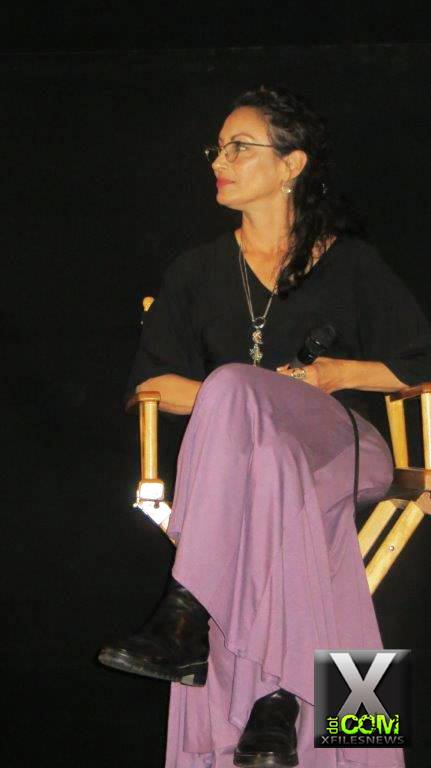 The X-Files’ Corey Kaplan
The X-Files’ Corey Kaplan
Corey Kaplan came into an already established television show at the beginning of its 6th season, having never done a television series. After getting a call to interview for an open Production Design position on The X-Files due to her previous work with director/producer/cinematographer Michael Watkins and producer Bernie Caulfield, she showed up armed with an art portfolio and a skateboard. Choosing to be herself in the interview, thinking she would never get the job, she told them their show was art. She got the job. What came next is a testament to her talent and perseverance as a designer. Without any architectural drawings for the sets from Vancouver, she re-created sets from photos. The first set for season 6 was the nuclear power plant complete with a tank and an alien shedding its skin. With crew taking bets on how long she would last, she made a scaled model of the set in her den in the wee hours of the morning and then pitched it as a permanent set. Remarkably, the set was built and then used throughout the rest of the series as Mulder’s basement, a ship holding compartment, a high tech jail, an oil rig interior, an NSA workspace, and so on. When the show ended in 2002, it was the last set to come down. Of particular note, was Corey’s ability to pick up on design elements found throughout the first five seasons and carry them forward in a way that flowed seamlessly for the television viewer. Her wild success on The X-Files garnered her an Emmy nomination and two Art Director’s Guild awards for Excellence in Production Design. Her later work on Cold Case, and currently on Scandal, shows that her employment on The X-Files was anything but a fluke.

